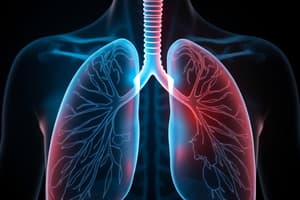Podcast
Questions and Answers
What is the name of the persistent inflammatory process responsible for the hyperreactivity of the bronchi in asthma?
What is the name of the persistent inflammatory process responsible for the hyperreactivity of the bronchi in asthma?
Inflammation in the bronchi
Which of these is NOT a symptom of COPD?
Which of these is NOT a symptom of COPD?
- Cough
- Itchy, watery eyes (correct)
- Fatigue
- Excess mucus production
Smoking cessation is recommended for all patients regardless of the age or severity of COPD.
Smoking cessation is recommended for all patients regardless of the age or severity of COPD.
True (A)
What is the term used to describe the irreversible obstruction of airflow that is a characteristic feature of COPD?
What is the term used to describe the irreversible obstruction of airflow that is a characteristic feature of COPD?
What is the most important group of drugs used for long-term asthma control and inhibiting the underlying airway inflammation?
What is the most important group of drugs used for long-term asthma control and inhibiting the underlying airway inflammation?
Which of the following is an adverse effect of oral corticosteroids?
Which of the following is an adverse effect of oral corticosteroids?
What is the name of the protein that inhibits phospholipase A2, thus preventing the formation of prostaglandins, leukotrienes, and PAF, in the anti-inflammatory action of glucocorticoids?
What is the name of the protein that inhibits phospholipase A2, thus preventing the formation of prostaglandins, leukotrienes, and PAF, in the anti-inflammatory action of glucocorticoids?
Mineralocorticoids are primarily responsible for regulating salt and water metabolism.
Mineralocorticoids are primarily responsible for regulating salt and water metabolism.
Which of these is NOT a therapeutic use of corticosteroids?
Which of these is NOT a therapeutic use of corticosteroids?
What is the name of the condition that results from a deficiency in corticosteroids produced by the adrenal cortex?
What is the name of the condition that results from a deficiency in corticosteroids produced by the adrenal cortex?
What is the name of the medical emergency that arises from a deficiency in cortisol and is treated with intravenous hydrocortisone and fluids?
What is the name of the medical emergency that arises from a deficiency in cortisol and is treated with intravenous hydrocortisone and fluids?
What is the key symptom of allergic rhinitis that antihistamines are effective in relieving?
What is the key symptom of allergic rhinitis that antihistamines are effective in relieving?
Second-generation antihistamines have a higher risk of sedative effects than first-generation antihistamines.
Second-generation antihistamines have a higher risk of sedative effects than first-generation antihistamines.
Terfenadine is a second-generation antihistamine with a low risk of cardiac side effects.
Terfenadine is a second-generation antihistamine with a low risk of cardiac side effects.
What is the term used to describe the physiological antagonism of histamine effects?
What is the term used to describe the physiological antagonism of histamine effects?
What is the term used to describe the competitive blockade of histamine receptors by antihistamines?
What is the term used to describe the competitive blockade of histamine receptors by antihistamines?
H1 antihistamines are effective in treating asthma.
H1 antihistamines are effective in treating asthma.
Which of these is NOT a common side effect of first-generation antihistamines?
Which of these is NOT a common side effect of first-generation antihistamines?
Which of the following is a common side effect of benzonatate?
Which of the following is a common side effect of benzonatate?
Coughing is always a sign of a serious underlying illness.
Coughing is always a sign of a serious underlying illness.
Which of the following is NOT a common side effect of opioid-based cough suppressants?
Which of the following is NOT a common side effect of opioid-based cough suppressants?
What is the name of the synthetic derivative of morphine that is used as a cough suppressant with a lower risk of addiction?
What is the name of the synthetic derivative of morphine that is used as a cough suppressant with a lower risk of addiction?
What is the name of the cough suppressant that acts peripherally by anesthetizing the stretch receptors in the respiratory passages?
What is the name of the cough suppressant that acts peripherally by anesthetizing the stretch receptors in the respiratory passages?
Histamine is released only in response to an allergic reaction.
Histamine is released only in response to an allergic reaction.
Histamine acts as a neurotransmitter in the brain.
Histamine acts as a neurotransmitter in the brain.
H2 receptor antagonists are effective at treating allergic reactions.
H2 receptor antagonists are effective at treating allergic reactions.
Second-generation H1 antagonists are more selective for H1 receptors and have fewer anticholinergic effects than first-generation H1 antagonists.
Second-generation H1 antagonists are more selective for H1 receptors and have fewer anticholinergic effects than first-generation H1 antagonists.
First-generation H1 antagonists can be used safely to treat patients with epilepsy due to a lack of effect on the central nervous system.
First-generation H1 antagonists can be used safely to treat patients with epilepsy due to a lack of effect on the central nervous system.
Sodium cromoglicate can suppress IgE-induced histamine release from mast cells
Sodium cromoglicate can suppress IgE-induced histamine release from mast cells
Which of the following is NOT a mechanism by which drugs can oppose the effects of histamine?
Which of the following is NOT a mechanism by which drugs can oppose the effects of histamine?
Corticosteroids are considered the most effective long-term controllers of choice for managing asthma.
Corticosteroids are considered the most effective long-term controllers of choice for managing asthma.
Glucocorticoids suppress the release of histamine by directly inhibiting histamine synthesis.
Glucocorticoids suppress the release of histamine by directly inhibiting histamine synthesis.
What is the primary human glucocorticoid that is produced in a diurnal pattern, peaking early in the morning and decreasing in the late afternoon?
What is the primary human glucocorticoid that is produced in a diurnal pattern, peaking early in the morning and decreasing in the late afternoon?
Glucocorticoids promote protein synthesis in all tissues.
Glucocorticoids promote protein synthesis in all tissues.
Mineralocorticoids are mainly involved in controlling blood sugar levels.
Mineralocorticoids are mainly involved in controlling blood sugar levels.
What is the name of the condition caused by a deficiency in corticosteroids, characterized by weakness, fatigue, and low blood pressure?
What is the name of the condition caused by a deficiency in corticosteroids, characterized by weakness, fatigue, and low blood pressure?
Long-acting beta-2 agonists are considered first-line treatment for COPD for patients with mild symptoms and low risk.
Long-acting beta-2 agonists are considered first-line treatment for COPD for patients with mild symptoms and low risk.
Tiotropium is a short-acting anticholinergic agent used for the treatment of COPD.
Tiotropium is a short-acting anticholinergic agent used for the treatment of COPD.
Intranasal corticosteroids are the most effective treatment for allergic rhinitis.
Intranasal corticosteroids are the most effective treatment for allergic rhinitis.
What is the term used to describe the narrowing of the airways during an asthma attack, often provoked by allergens, irritants, or exercise?
What is the term used to describe the narrowing of the airways during an asthma attack, often provoked by allergens, irritants, or exercise?
What is the name of the drug that competitively inhibits type III and type IV phosphodiesterase, resulting in bronchodilation and is less commonly used in asthma treatment nowadays?
What is the name of the drug that competitively inhibits type III and type IV phosphodiesterase, resulting in bronchodilation and is less commonly used in asthma treatment nowadays?
Omalizumab is a monoclonal antibody that selectively binds to mast cells to suppress the release of histamine, preventing allergic reactions.
Omalizumab is a monoclonal antibody that selectively binds to mast cells to suppress the release of histamine, preventing allergic reactions.
First-generation antihistamines are generally preferred over second-generation antihistamines for the treatment of allergic rhinitis.
First-generation antihistamines are generally preferred over second-generation antihistamines for the treatment of allergic rhinitis.
Systemic corticosteroids are the preferred treatment option for patients with chronic rhinitis.
Systemic corticosteroids are the preferred treatment option for patients with chronic rhinitis.
Roflumilast is a bronchodilator used to treat acute bronchospasm in COPD.
Roflumilast is a bronchodilator used to treat acute bronchospasm in COPD.
Antihistamines are more effective in preventing allergic rhinitis symptoms than treating them once they have already developed.
Antihistamines are more effective in preventing allergic rhinitis symptoms than treating them once they have already developed.
Theophylline is often used as the first-line treatment for asthma.
Theophylline is often used as the first-line treatment for asthma.
Antihistamines are effective in relieving the symptoms of asthma.
Antihistamines are effective in relieving the symptoms of asthma.
The adrenergic agonist formulations of nasal decongestants should be used for no longer than 3 days to avoid rebound nasal congestion
The adrenergic agonist formulations of nasal decongestants should be used for no longer than 3 days to avoid rebound nasal congestion
Flashcards
Asthma characteristics
Asthma characteristics
Asthma is a chronic respiratory disease marked by hyperreactive airways, leading to acute bronchoconstriction and shortness of breath. It is often triggered by environmental factors and biological factors like allergens, viruses and environmental chemicals.
Asthma quick relief
Asthma quick relief
Short-acting beta-2 agonists (SABAs) are used to rapidly relieve asthma symptoms by relaxing airway muscles.
Asthma long-term control
Asthma long-term control
Long-acting beta-2 agonists (LABAs) are used alongside inhaled corticosteroids (ICS) to maintain asthma control over an extended period by providing long-lasting bronchodilation.
Inhaled corticosteroids (ICS)
Inhaled corticosteroids (ICS)
Signup and view all the flashcards
COPD characteristics
COPD characteristics
Signup and view all the flashcards
COPD treatment
COPD treatment
Signup and view all the flashcards
Allergic Rhinitis
Allergic Rhinitis
Signup and view all the flashcards
Allergic Rhinitis Treatment
Allergic Rhinitis Treatment
Signup and view all the flashcards
Study Notes
Respiratory System
- Asthma, chronic obstructive pulmonary disease (COPD), and allergic rhinitis are common respiratory disorders.
- Asthma is characterized by hyperresponsive airways and acute bronchoconstriction, causing shortness of breath.
- Allergic rhinitis involves itchy, watery eyes, a runny nose, and a nonproductive cough.
- COPD involves incompletely reversible airways obstruction and mucus hypersecretion, primarily affecting the smaller airways.
- Drugs for respiratory conditions can be delivered topically, inhaled, orally, or parenterally. Local delivery methods are preferred to minimize systemic effects.
Asthma
- Bronchial hyperreactivity is a result of persistent inflammation caused by biological agents (e.g., allergens, viruses), and environmental factors (e.g., ozone).
- Inflammatory mediators from various cells (mast cells, eosinophils, neutrophils, monocytes, and macrophages) are released.
- Some mediators, like histamine, cause immediate bronchial reactions. Others cause sustained bronchoconstriction after cell activation.
- Preferred drugs for asthma:
- B2-Adrenergic agonists: These relax airway smooth muscle.
- Short-acting B2 agonists (SABAs) provide quick relief (5-30 minutes) for 4-6 hours; essential for symptomatic treatment
- Long-acting B2 agonists (LABAs) provide longer-lasting relief (12+ hours) but aren't suitable for immediate relief. Never use LABAs alone.
- Inhaled corticosteroids (ICS): Long-term control of asthma inflammation.
- B2-Adrenergic agonists: These relax airway smooth muscle.
- Asthma treatment requires a combination of drug therapies, not just SABAs (short-acting bronchodilators.)
Other Treatments for Respiratory Issues
- Corticosteroids: Effective for long-term control in patients with persistent asthma. Reduce inflammatory cascade and improve airway responsiveness.
- Leukotriene Modifiers: Effective adjunctive treatment to control asthma, especially when conventional therapy is insufficient, especially in combination with inhaled corticosteroids.
- Cromolyn: A prophylactic agent that inhibits mast cell degranulation and histamine release. Suitable for mild, persistent asthma, but not for acute attacks due to slow onset.
- Cholinergic antagonists: Block vagally-mediated airway constriction and mucus secretion. Useful, but not as first line for asthma, mainly for acute exacerbations used in combination with SABA inhalers in emergency departments.
- Theophylline: A bronchodilator. Its use is less common now due to a narrow therapeutic window and potentially hazardous adverse effects. Usually replaced by more manageable treatments.
- Omalizumab: A monoclonal antibody that blocks IgE. Main use in severe persistent asthma that is not well controlled with other medications.
Studying That Suits You
Use AI to generate personalized quizzes and flashcards to suit your learning preferences.




